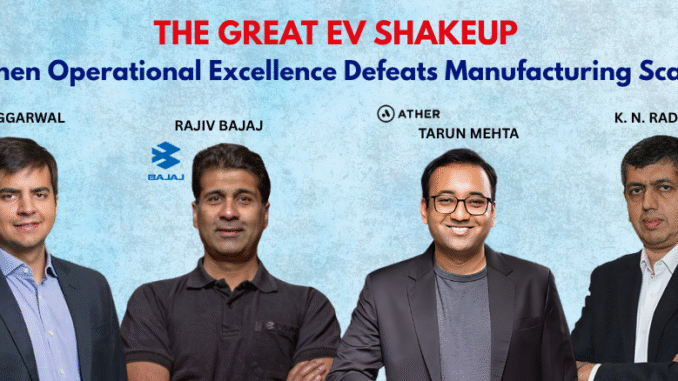
What happens when relentless scaling meets unforgiving reality in India’s electric mobility battleground? September 2025 delivered the brutal answer—a 42% market collapse that didn’t just topple a giant, it demolished every assumption about sustainable growth in a sector charging toward 30% market dominance by 2030.
The Numbers Tell a Dramatic Story
Based on data as of October 2, 2025, the September registration figures paint a picture of intense competitive volatility. TVS Motor maintained its leadership with 22,491 units, despite a 7.9% month-over-month decline from August’s 24,268 units. The real headlines emerged in the middle of the pack: Bajaj Auto executed a spectacular surge from 11,822 units in August to 19,554 in September—a remarkable 39.5% jump that catapulted them from fourth to second place.
Ather Energy demonstrated remarkable stability amid the turmoil, registering 18,095 units compared to August’s 18,052—virtually flat at 0.2% growth. However, the month’s most dramatic story belonged to Ola Electric, whose registrations collapsed 42.2% from 19,020 units to just 13,374, marking a stunning fall from grace for the former market darling.
| Aug’25 | Sept’25 | M-o-m (Aug’25 vs Spet’25) | |
| TVS MOTOR COMPANY LTD | 24,268 | 22,491 | -7.900938153 |
| BAJAJ AUTO LTD | 11,822 | 19,554 | 39.54178173 |
| ATHER ENERGY LTD | 18,052 | 18,095 | 0.2376347057 |
| OLA ELECTRIC TECHNOLOGIES PVT LTD | 19,020 | 13,374 | -42.21624047 |
Source: Vahan Dashboard as of 2nd Oct 2025. Excludes Telangana sales figure.
Strategic Foundations Behind the Numbers
This competitive reshuffling reflects deeper strategic differences now playing out in market performance. TVS Motor’s consistent leadership stems from decades of brand trust, comprehensive dealer networks, and steady product innovation in the electric segment. Their ability to maintain the pole position even during supply constraints demonstrates the power of operational excellence combined with extensive reach.
Bajaj Auto’s meteoric rise represents the payoff from resolving earlier 2025 production challenges. The September surge signals successful supply chain fixes and renewed focus on its electric Chetak lineup—a smart blend of heritage and innovation that resonates with consumers.
Ather’s Quiet Resilience vs. Ola’s Service Crisis
While most players experienced dramatic swings, Ather Energy’s performance underlines strategic wins. The Bengaluru-based company expanded aggressively beyond southern strongholds through rapid retail rollouts. Its family-focused Rizta model, launched in April 2024, crossed 100,000 retail sales within a year by June 2025, showcasing exceptional market acceptance.
Conversely, Ola Electric’s collapse underscores systemic challenges beyond product specs. The company faced over 10,000 complaints lodged with India’s Central Consumer Protection Authority between September 2023 and August 2024—an unprecedented volume that triggered regulatory probes into Ola’s service and resolution claims. These service failures have eroded consumer confidence despite the company’s manufacturing scale and technological capabilities.
Market Context and Broader Trends
September’s shifts occur against a backdrop of robust sector growth. Electric two-wheeler registrations rose 18% year-on-year in H1 FY26, underlining strong underlying demand despite competitive volatility. As the market transitions from early-adopter to mass-market dynamics, reliability, service quality, and the total cost of ownership are becoming decisive factors.
TVS’s sustained leadership illustrates the advantage of leveraging established automotive expertise. Bajaj’s resurgence proves that traditional OEMs can pivot successfully to EVs with the right operational fixes. Ather’s resilience validates a premium, quality-focused approach in an increasingly discerning market.
Looking Ahead
September 2025 may be remembered as the turning point when operational excellence overtook sheer manufacturing scale as the key to sustained market leadership. As India approaches its 30% electric two-wheeler penetration target by 2030, success will increasingly depend on mastering both vehicle innovation and the end-to-end ownership experience.
The future belongs to those who can build outstanding electric vehicles—and then back them up with exceptional service throughout their lifecycle. September’s data signals that this comprehensive approach is now the ultimate competitive advantage.



